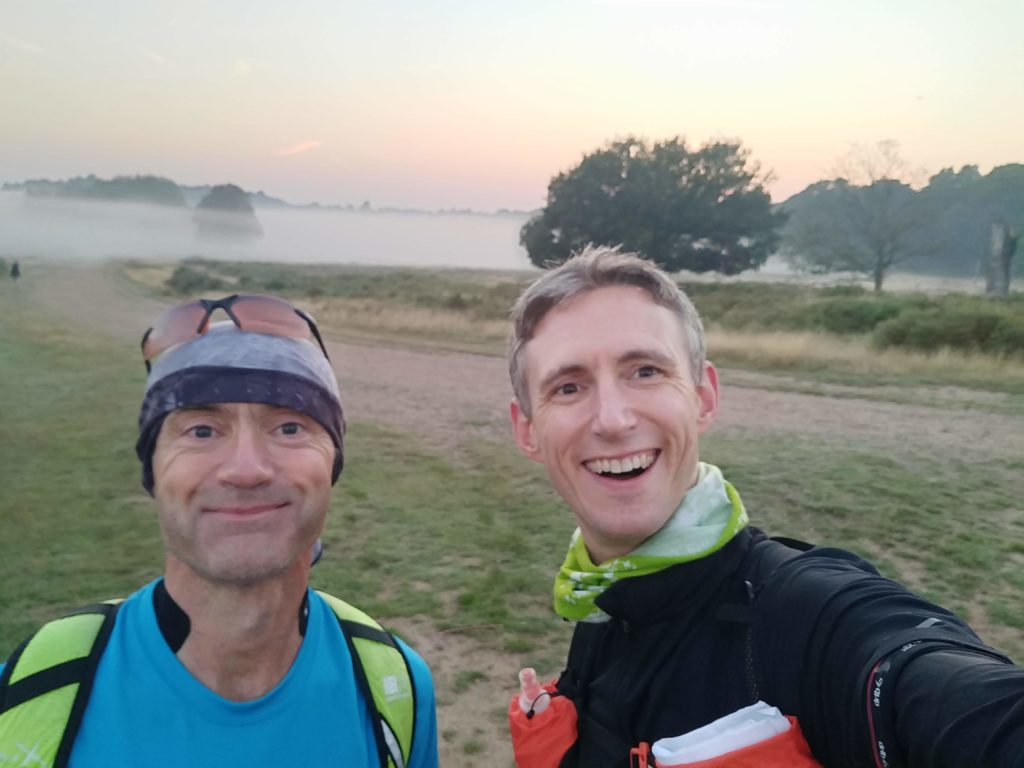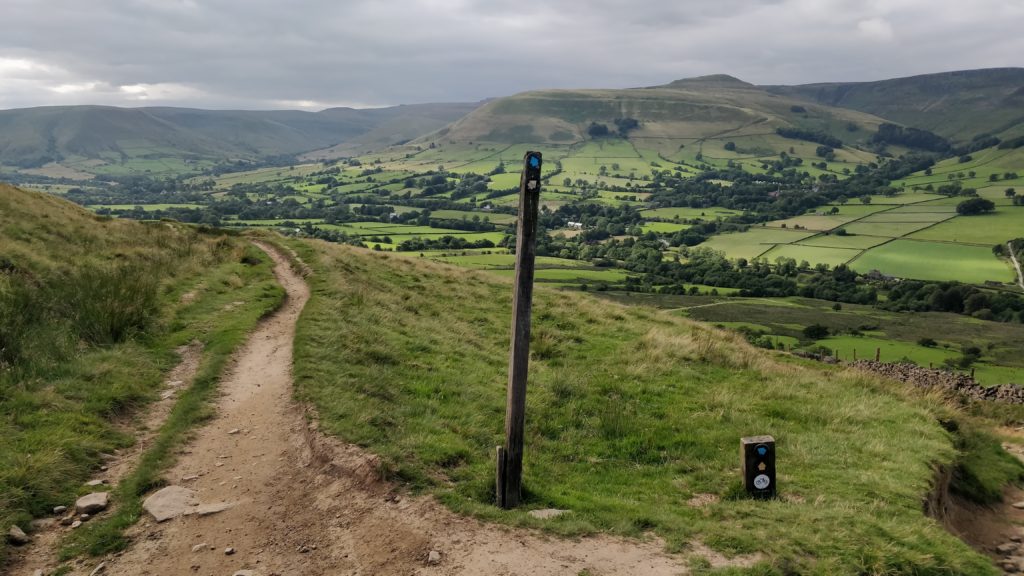From Windmiler Gareth Tomlinson
Adventure running has fast become a huge part of the wider running mix, with trail, fell, ultra, fastpacking and multi-day events becoming almost as popular as road and track running. Getting out and enjoying time moving in the wild is something we can all relate to.
Wimbledon Windmilers has members active in all of these areas, with various long-distance challenges, 100-mile races, national trails, fell races and 24 hour mountain missions completed in the club vest.

Trail
Defining “trail running” is simple. If you run on any surface other than pavement or road, you’re a trail runner! We are very lucky to have some of the best trail running in London right on our doorstep, with Wimbledon Common, Putney Heath and Richmond Park all within easy reach. We also have easy access to both the Thames and Wandle river paths, and within one hour by train or road, access to the North Downs which feature extensive trail running options.
There are no rules or barriers to trail running, just be safe, be considerate, follow the countryside code and to quote John Muir, “Take noting but photographs, leave nothing but footprints, kill nothing but time.”
Often runners who are looking to increase their distances, will use trails for their longer runs because the softer, more varied terrain is kinder to joints and fatigued muscles than concrete and tarmac.
You don’t need any specialist equipment, although often a shoe with a little more grip and a slimmer sole, to minimise the twist on your ankles over uneven terrain, can be useful. Depending on the length of your runs, you may also want to carry a rain jacket, “There’s no such thing as bad weather, only unsuitable clothing.” (Alfred Wainwright).
It’s a good idea to bring a drink, snack, and perhaps a torch, and using a map and compass is often advisable when exploring new areas. There are also lots of options for route finding using smartphones; just make sure your device is waterproof and your batteries are charged! You may also want to invest in a running belt, race vest or lightweight pack to carry essentials.


Ultra
Ultra running is defined as anything over 26.2 miles, which is a pretty broad definition! The Windmilers have members with extensive experience in a variety of events and you’ll be sure to bump into someone at the Sunday long run who can offer some advice or even keep you company if you succumb to the lure of the longer run.
Ultras are also often referred to as an eating contest with some occasional light exercise mixed in. Pacing, nutrition and body management play an increasingly important role as the distances and times go up.
As you will be outdoors for longer, you will probably want to invest in some good all-weather kit to guard against the elements. Almost certainly, you will be carrying food and drinks on longer runs, as well as learning new skills around how to eat, drink and manage yourself on the move. Good planning makes for a more enjoyable experience.
On the other side of the equation, the intensity level tends to be lower and walk breaks are not just allowed, but actively encouraged. If you keep moving forward, you will get there! At organised events, there are also usually numerous “aid stations” which tend to be a pretty good buffet of snacks, sweets, fruit and goodies. Water is also normally provided on the course, but you’ll need to check if it’s necessary to carry your own cup / bottle.
The ultra race scene has become quite competitive in recent years, with some fast times at the front of the field, but the friendly “challenge” ethos is still strong and while there might be time limits for some events, they are usually generous enough for most runners to complete the event if they are sensible and pace themselves well.
The main event distances tend to be 50km, 50 miles, 100km and 100miles, although there can be discrepancies between the advertised and actual distances, and routes can also involve significant elevation which is an important consideration. 50km will be the starting point for most people and at just over a marathon + a park run, it’s within grasp for most distance runners.
TIP Keep your effort to a level where you can hold a conversation. It will keep your pacing in check, and you might make new friends on the way.
TIP If you feel low then drink more. If you still feel low, eat more. If you still feel low, slow down!
TIP Pack some loo roll in a zip-lock bag – you never know when it might come in handy…


Fell (mountain) running
The English sport of fell running, known as mountain running in other countries, has a long and rich history. The sport has its roots in a display of virility! Gnarly sheep farmers used to stage races at local fetes to advertise the quality of their stock. They would show their strength racing up the nearest lung-busting ascent before displaying their bravery in a death-defying descent. The races and fetes are still there but the shoes have certainly become more technical, and expensive! It’s also much less of an all-male affair!
What has remained is the low-key, no-frills appeal of fell running. Courses are often unmarked, with navigation, route selection and the ability to move quickly over rough, steep and often un-tracked ground as much as part of the challenge as the pure physical effort of running, especially when the clouds come down and visibility is significantly diminished. There is something enduringly charming about emerging from the mist to meet a hardy volunteer who checks you off with a nod on a remote mountain summit, before you go careening off the side of a mountain. Race fees tend to be less than a central London pint and you’re more likely to get a bottle of beer for your trouble than a technical t-shirt. At a recent “long” winter event, the author joined a sizable group washing off the mud and bog in a river under the village bridge.
The Fell Runners Association is the UK organising body for this most rewarding of sports and they have lots of information on their website. Races vary in length and vertical ascent. “A” races have the most climb, “C” the least, then Short (S), Medium (M) and Long (L) are pretty self-explanatory. Races in the calendar will be marked AS, BM, CL etc. so you know what you’re in for. I should also add that, as races get longer and steeper, there is also a fair amount of walking on the uphill sections by mere mortals!
Most, but not all races do not permit the use of GPS for navigation, some require proof of experience, and there are minimum kit requirements to race. These are checked but it’s also your duty to yourself and your fellow runners to do the right thing. The courses are not fixed or marked so if you get into trouble, you’re relying on yourself, passing competitors, walkers or mountain rescue for help. There are unlikely to be the “aid stations” you find at ultra events, but you will come across a good spread and some strong orange squash at points during the very long AL races, such as Old County Tops or The Fellsman. On most races you will need to be self-sufficient and either carry food and water or source it on route!
If fell running sounds a little rustic, a number of more commercially organised mountain runs have begun to spring up in recent years. These are likely to have marked routes, therefore more foot traffic and probably a tail runner for safety. The are likely to feature more aid stations and will maybe even that elusive t-shirt! The author still heartily recommends self-sufficiency including carrying a map and compass (and knowing how to use them), but perhaps he is just old fashioned.
For navigation practice closer to home, consider taking part in some Orienteering events (check out slow.org.uk for local options), or just running Orienteering courses using apps such as MapRun. There are free virtual courses on the Common and in Richmond park. More details can be found on www.goorienteering.org.uk

And beyond...
With your new-found ultra, mountain and navigational skills, what’s stopping you? Windmiler members have completed various multi-day adventures, from fastpacking across national trails, to classics such as the Marathon des Sables, and even the ultimate adventure, UTMB. If you have an adventure in mind and you’d like some advice, or even some company, just get in touch with the Windmilers Communications team or Coaching Representatives, who will be able to either connect you to some like-minded souls.

Recommended local routes
Our very own Wimbledon Common which you can link up via Robin Hood Gate to the Tamsin Trail in Richmond Park
Thames Towpath – head west or east!
Follow the Wandle all the way to Croydon!
Box Hill to Reigate (and back if you’re keen)
“Midsummer Munro” out and back route from Box Hill café
The Capital Ring – a great adventure which passes straight through the heart of Wimbledon. Complete in stages or in a “oner” if you’re keen!
Links for more information:
gofar.org.uk – lots of ideas for adventures all over the country
irunfar.com – International Ultra news and events
SLOW – local orienteering club for navigation skills and practice and home of one of the two fell races in the South East, the ever popular Box Hill Fell Race!
Safety
Something we hope never to need.
Of course, you should consider your safety in all of your running but it matters even more when you are off the beaten track, potentially in remote and difficult terrain. This isn’t a safety check list but more of a guide of some things to think about.
1. If possible, try not to run alone. Not only is it more fun in a group, it’s also much safer!
2. Carry route details and a way to navigate. I prefer a map and compass as they don’t run out of battery but these are only any good if you can use them effectively when the wind picks up and the mist comes down! Most phones now have a GPS and can display mapping. If relying on your phone, make sure it’s waterproof and the batteries will last. Also, expect not to have internet connection – if you do, it’s a bonus! Check out the OS Maps app or Outdoor Active for good mapping with the ability to store maps offline.
3. Try to be self-sufficient, and respectful of the volunteers who might have to come rescue you, but call for help before you deteriorate into a bad state. Mountain Rescue would rather guide off a lost runner than carry off a bad casualty.
4. Always leave details of your trip with someone. If possible, someone wrapped up safely at home but in the worst case, you can leave a note in the windscreen of your car. Include an outline of your route, start time, expected finish time (be generous!) and a time at which people should begin to worry. If you’re leaving details with someone inexperienced, write down who to contact, how and when and include what to say to them. An example might be calling 999 and asking for mountain rescue: “My name is YYY and my number is YYYY. My partner set out for a run and I’ve not heard from him beyond the time he expected to check back in and he asked me to call you. He set out to run up solo to Snowdon summit at 0900 following the Watkin path from Pont Bethania, returning the same way. He expected to return by 1400 and said to call at 1530 if I hadn’t heard. His name is Gareth Tomlinson, mid 40’s male, wearing a dark green base layer, red fleece and black waterproof with orange backpack. He is experienced, has water, food, whistle, torch and a foil blanket with him. His number is XXX.”
5. Consider using an app with a “buddy beacon” feature. This lets your nearest and dearest track you. Just be aware that these do rely on an internet connection so let your followers know not to panic if they don’t see you move for a while.
6. Be reasonable with your expectations and carry suitable provisions for your planned duration. If you’ve only ever run a flat half marathon, don’t head out solo for 80km across the mountains! Carry or have guaranteed means to get enough water, food and warming clothing for your expected time out. If expecting to find water from your surroundings, consider how you will purify it. There might be something unpleasant in that stream 50m up from where you are.
7. Keep an emergency kit for longer adventures and try to only use it in an emergency! As a minimum I carry a spare warm layer, whistle, small torch, some strapping tape, small scissors to cut it, a foil bivi bag and a gel.
8. Carry a hat and gloves and keep your warm clothes as dry as possible. Freezer ziplock bags are ideal for this!
9. Stay alert for hyperthermia. This could be a topic for a whole webpage but as a friend once said to me “any idiot can get cold, it takes a wise person to stay warm”. Add layers before you think you “need them”. Zipping up a jacket or putting on gloves can be hard with frozen fingers. Also be very aware of wind and when you might get into exposed positions. It can be fine climbing a hill but when you get to the exposed ridge or summit, it can get very cold very fast and a comfortable situation can go downhill very quickly.
Of course this is all just part of body management and very much part of the game. If you’re not sure, perhaps seek some more experienced company but don’t let it put you off!


